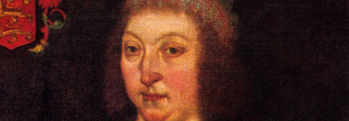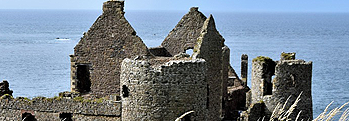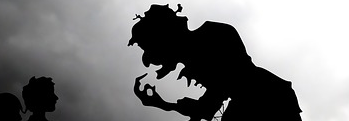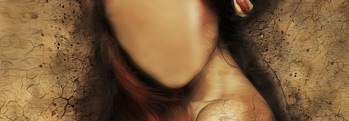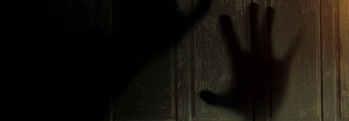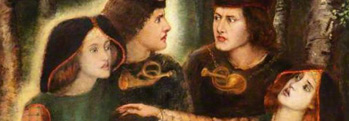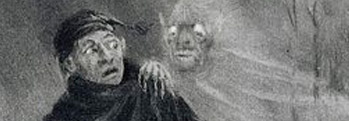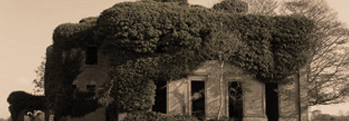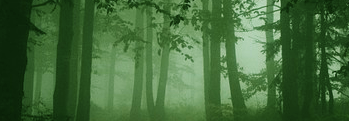Seafield House
Irish and Celtic myths and legends, Irish folklore and Irish fairy tales and Irish Ghost Stories
Cryptic mysteries in Seafield House
William Phibbs was a well-to-do landlord of the English nobility who decided to develop his considerable estates in Ireland, building a house for himself overlooking the beautiful Ballisodare Bay in Sligo back in 1798. It would be a fine place to enjoy the sunset over Atlantic waters, he decided, and his son used it so. His grandson, also named William, loved the place so much that he had a much larger and finer mansion built there in 1840, making it his main residence in Lisheenacooravan, the little fort on the white hill.
 His son Owen Phibbs was an archaeologist of some repute, travelling the world as was the fashion among such gentleman-explorers, excavating and retrieving many ancient artifacts and relics. He went abroad to Syria, Egypt, and across the middle east, finding relics among the musty old ruins of those places, some perhaps better left undisturbed if subsequent events were anything to go by!
His son Owen Phibbs was an archaeologist of some repute, travelling the world as was the fashion among such gentleman-explorers, excavating and retrieving many ancient artifacts and relics. He went abroad to Syria, Egypt, and across the middle east, finding relics among the musty old ruins of those places, some perhaps better left undisturbed if subsequent events were anything to go by!
His vessels and vases, statues and icons were displayed in a long gallery on the first floor of the house, and soon after they arrived strange things began to happen around the house, although whether they were the cause or they roused something already there isn't known. People sleeping in the house complained of drafts, chills in the air and strange noises, then rapping at the walls and ceiling. A dark figure was seen on the stairs and the gardener fled his employment after reporting the same figure running cackling into the ocean one dark evening.
Things quickly grew worse and shattering sounds disturbed the night, thumping and rattling, and furniture was found scattered about the place in the morning. It came to a head one moonless night when the entire house shook and trembled as though in a mighty earthquake, the entire staff ran from the building and refused to return, and so the house was abandoned.
Some places are reputedly haunted mainly for the benefit of their owners, but no such fortune attended the family Phibbs - valued at fifty five pounds sterling in 1905, the house, now called Lisheen, was deemed uninhabitable, although some Jesuit priests around that time tried to exorcise it by saying mass daily for weeks. They failed to dislodge whatever was brooding behind the sullen walls, and in their turn fled.
Other tales tell that Phibbs had a poor reputation as a landlord, treating his tenants most cruelly to keep himself in the opulent style to which he was accustomed. He'd have them salute as he rode by in his luxurious carriage, charged high rents and kicked out those who couldn't pay, taking the stones of their homes to line the walls of his fields.
One such evicted widow is said to have cast a dreadful curse upon the family in her last agonies, swearing that the day would come when the birds of the air would build their nests in the ruins of Seafield House, and she condemned the Phibbs to walk its halls forever after, in this life or the next, until the end of time.
And so it is today, magpies and crows are the sole inhabitants and inheritors of the place, only stoats peer from the windows now. Old Phibbs' coach and four is said to glide up to the ruins on certain nights and vanish afterwards, but nothing else tarries long at Seafield House.
The ruins of Seafield or Lisheen House can be found on the map below, although if you want my advice you'll stay well clear.
More Irish Ghost Stories
Mongán mac Fíachnai was a prince of the Gaels, none other than he whose father was Fíachnae mac Báetáin, and it was about the seventh century in Ireland when he ruled over Ulster. Many are the tales told of him and his royal reign, with some even whispering that he was the son of Manannán mac Lir, ancient G ... [more]
There once was a woman called Máire Rua, or Red Mary, since she was one of the McMahons and had hair like a fiery sunset with a temper to match! Many legends have grown up around this seventeenth century force of nature, some true, some maybe less so, and some she spread herself! She made her seat in Leamanagh Castle, in the Burren in Cou ... [more]
If Dublin is the capital city of Ireland, County Clare is its dark reflection on the other side of the country, a place where many of the shadowy tales and unsolved mysteries of bygone years eventually seem to flow. Layer upon layer of centuries burden its rocky hills, left behind by the passage of numberless and nameless peoples, each hiding their ... [more]
Little remains now of once-proud Dunluce castle, whose halls had echoed with the sounds of laughter and music, and whose vaulted arches had defied the most ferocious storms. Only echoes and shadows are left behind, and some say, the tormented ghost of a young lady waiting for her love to return! The castle had originally been built by Richard &O ... [more]
The tale of Kilmagoura in County Cork is, for the most part, a peaceful and quiet one, as it lay under the power of the Fitzgeralds for many years, and they were, for the most part, just and fair rulers. So good were they that nobody had anything bad to say about them, and tales were told of their heroism and generosity. But as they say, it is t ... [more]
The long shadow of Leap Castle in County Offaly stretches across many centuries, and from its dark depths echo tales of terror, murder and the dread hand of the supernatural reaching from beyond the grave! The land upon which the O'Bannon clan built Leap Castle in the thirteenth century was not unoccupied – in fact, it had been used by ... [more]
Once upon a time in Tyrone there were two little children, the son and daughter of parents who had died when they were little. They missed their parents very much, but they were raised by a guardian who was a fanatical atheist, and was determined to convert the children to his beliefs. But they would have none of it, and so they made a childhood ... [more]
Every year around Halloween, people carve pumpkins or turnips into faces and put candles inside them, but not many know that this custom came from Ireland originally, or the story behind it! They say there was a blacksmith many years gone who was fond of his drink, and a mean drunk he was too, and tight with it. Not many friends did stingy Jack ... [more]
There was a famous beauty who lived in Belvelly castle overlooking Cork Harbour in the seventeenth century, and word of her ethereal comeliness spread far and wide. It reached the ears of a local lord by the name of Clon Rockenby, and he declared he must have her for his wife. Her name was Lady Margaret Hodnett, and although she was quite fond o ... [more]
The Redmonds were a comfortably well off family living in Court street in Enniscorthy back in 1910, and they supplemented their income by renting out rooms in their house to lodgers. However, their quiet life was soon to be interrupted by a sinister guest they hadn't invited in! In July of that year they had rented out the room above the kit ... [more]
It was the year 1280 in Kyteler's House in Kilkenny that Dame Alice Kyteler was born to a family of good prospects, a family of Flemish merchants who had settled in Kilkenny. When she grew up, Alice married William Outlawe, a wealthy merchant and moneylender, by whom she had a son. Then she married to her second husband, Adam le Blund of Callan ... [more]
One of the oldest legends in Ireland is that of the Fetch, the ghost of the living, which some say comes down from the ancient Irish word for seer or prophet, fáith. It is a double-spirit, one which takes on the identical appearance of someone as an omen of their impending death, if seen in the evening, or as a promise of good fortune if see ... [more]
They do say Irish people are fond of a good chat, the gift of the gab as it's called, but it seems even Irish ghosts are likewise inclined, as the strange tale of Corney the phantom reveals! Many years ago in Dublin city, a young family moved into a fine residence in the heart of Dublin city. Well-to-do and respectable, they made their new h ... [more]
In the south of the country, from Cork to Waterford, parents often scold wilful children with the warning – behave or Petticoat Loose will get you! And a wise child will do as they are told, for there are few more chilling tales than those of Petticoat Loose. Patrick Flynn's wife was in her labour pains near Ballingeary on a cold night ... [more]
High on a windswept slope in the Wicklow mountains near the summit of Mount Pelier, with a commanding view overlooking Dublin city, lies the burnt and blackened shell of a sinister old hunting lodge, now called the Hellfire Club, and well named it was too! For it was home to the Irish branch of that selfsame society, notorious for drunken debaucher ... [more]
William Phibbs was a well-to-do landlord of the English nobility who decided to develop his considerable estates in Ireland, building a house for himself overlooking the beautiful Ballisodare Bay in Sligo back in 1798. It would be a fine place to enjoy the sunset over Atlantic waters, he decided, and his son used it so. His grandson, also named Wil ... [more]
The old house in Coonen is much spoken of even today, its dark legend stretching back into the mists of time. Some say it is a ghost living there, others say a devil, but rumours go back further into the darkness of elder years, to the old gods of Ireland and the dark rites that were celebrated in their name. The house in Cooneen first entered t ... [more]
The headless horseman is a very ancient tale of Ireland, stretching back to the days before Christ came with St Patrick, when a dark king used to sacrifice people to old black one-eye, Crom Cruach, by decapitation. That very same Crom Dubh, the worm god, who consumed the Druid Prince Cesard in green bubbling acid at the battle of Moy Tura after his ... [more]





